The Commercial Dishwasher Guide 2025
The Complete Commercial Dishwasher Buyer's Guide 2025
Master commercial dishwasher buying with real auction data from 340 sales. Compare Hobart, Noble, CMA brands, understand high-temp vs chemical sanitization, and avoid costly inspection mistakes. Expert guidance from America's premier restaurant equipment auction house.
Why the Dish Pit Determines Restaurant Success
The dish pit isn't glamorous. No customer ever chose a restaurant based on its dishwashing operation. But dirty plates presented to customers will empty a dining room faster than any other operational failure. Even a four-star restaurant looks like a dive when glassware has water spots or silverware shows residue from inadequate washing.
The dishwasher is where restaurants live or die. A broken dishwasher during service means hand-washing dishes in three-compartment sinks—an impossible bottleneck that crushes kitchen flow. The line cooks need clean pans. The servers need clean plates. The bartenders need clean glassware. Everything stops when the dishwasher fails.
Commercial dishwashers process this volume at speeds residential units cannot match. A pass-through dishwasher completes a full cycle in two minutes—from door close to door open. Compare this to residential dishwashers requiring 60-180 minutes per load. This speed difference isn't luxury—it's operational necessity. During a dinner rush, the dish pit processes hundreds of plates, bowls, glasses, and utensils per hour. Residential equipment would cause immediate failure.
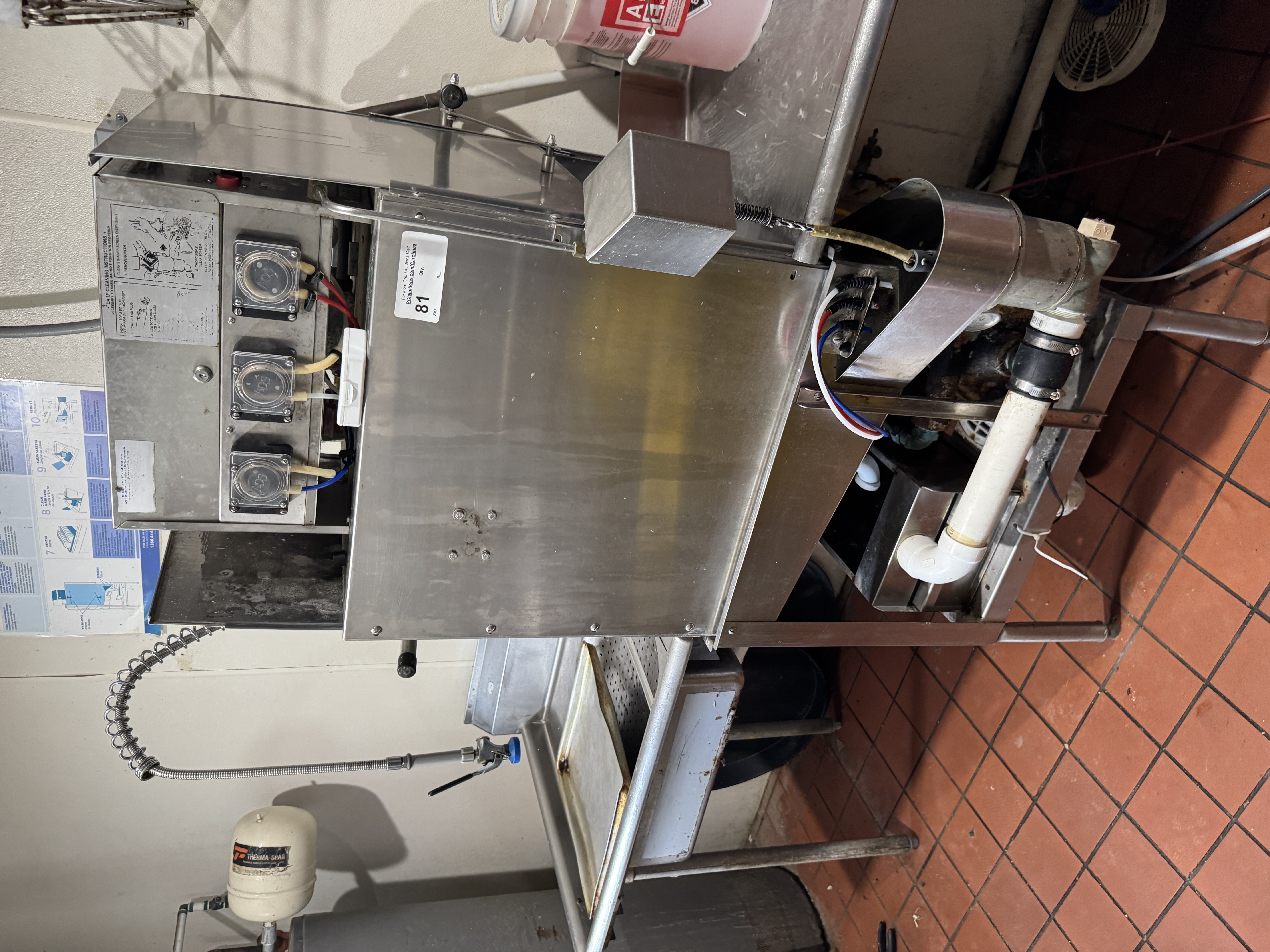
Understanding Commercial Dishwasher Types
Commercial dishwashers divide into three categories based on volume requirements and physical space constraints.
Undercounter Dishwashers: The Versatile Foundation
Undercounter units occupy roughly the same footprint as residential dishwashers but deliver dramatically different performance. These machines fit beneath standard countertops and operate as self-contained washing stations. Many restaurants install dedicated undercounter units at the bar, creating independent dish islands that prevent bartenders from walking to the back-of-house dish pit during service.

For smaller operations—coffee shops, cafes, small restaurants—the undercounter solution handles all dishwashing needs without requiring dedicated dish pit space. The versatility and speed make undercounter dishwashers the most popular choice.
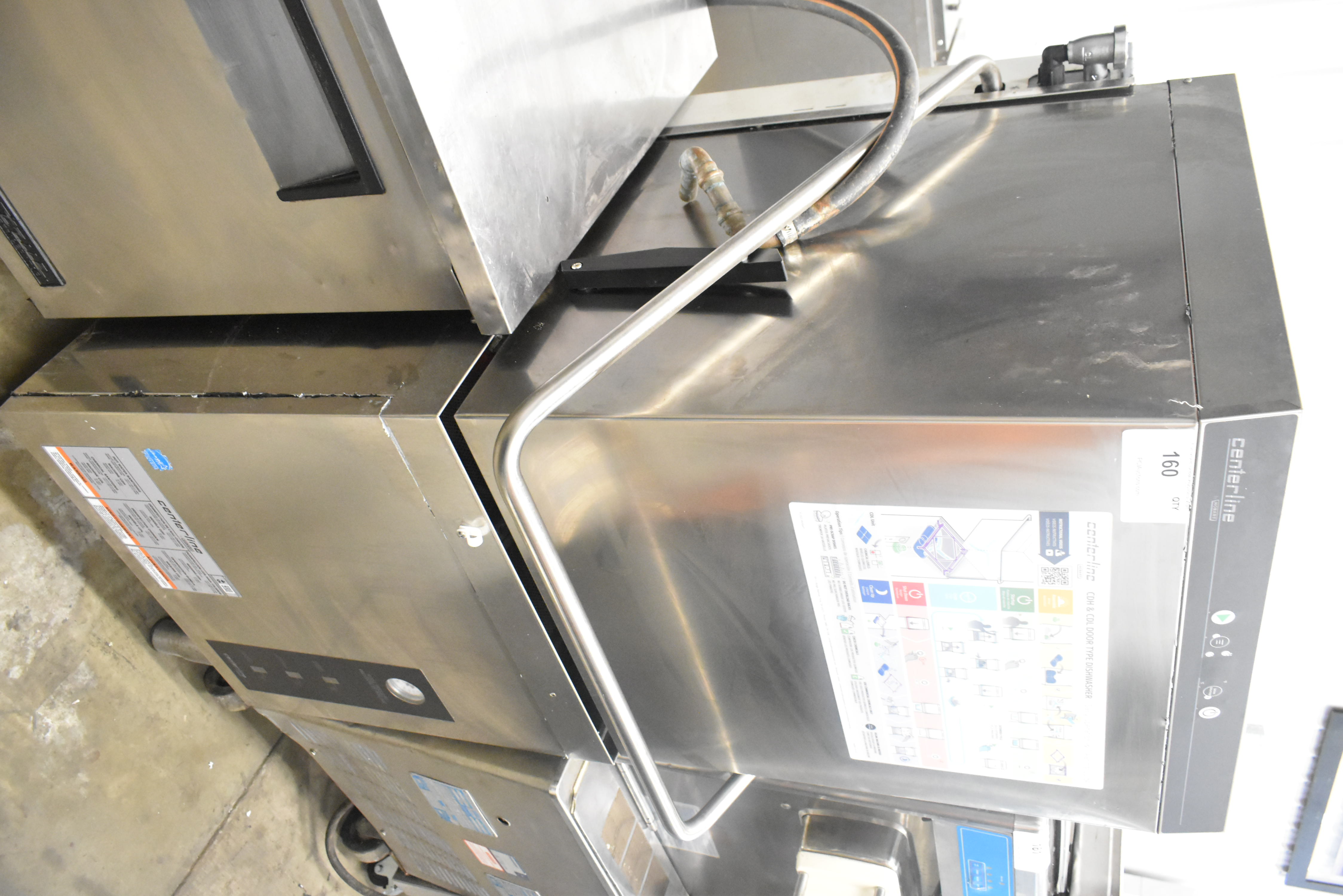
Pass-Through Dishwashers: Industry Standard Workhorses
Pass-through (also called door-type) dishwashers represent the industry standard for most restaurants. These units integrate into a three-station dish pit system: dirty side table, dishwasher, clean side table. This configuration creates a continuous workflow that processes large volumes efficiently.
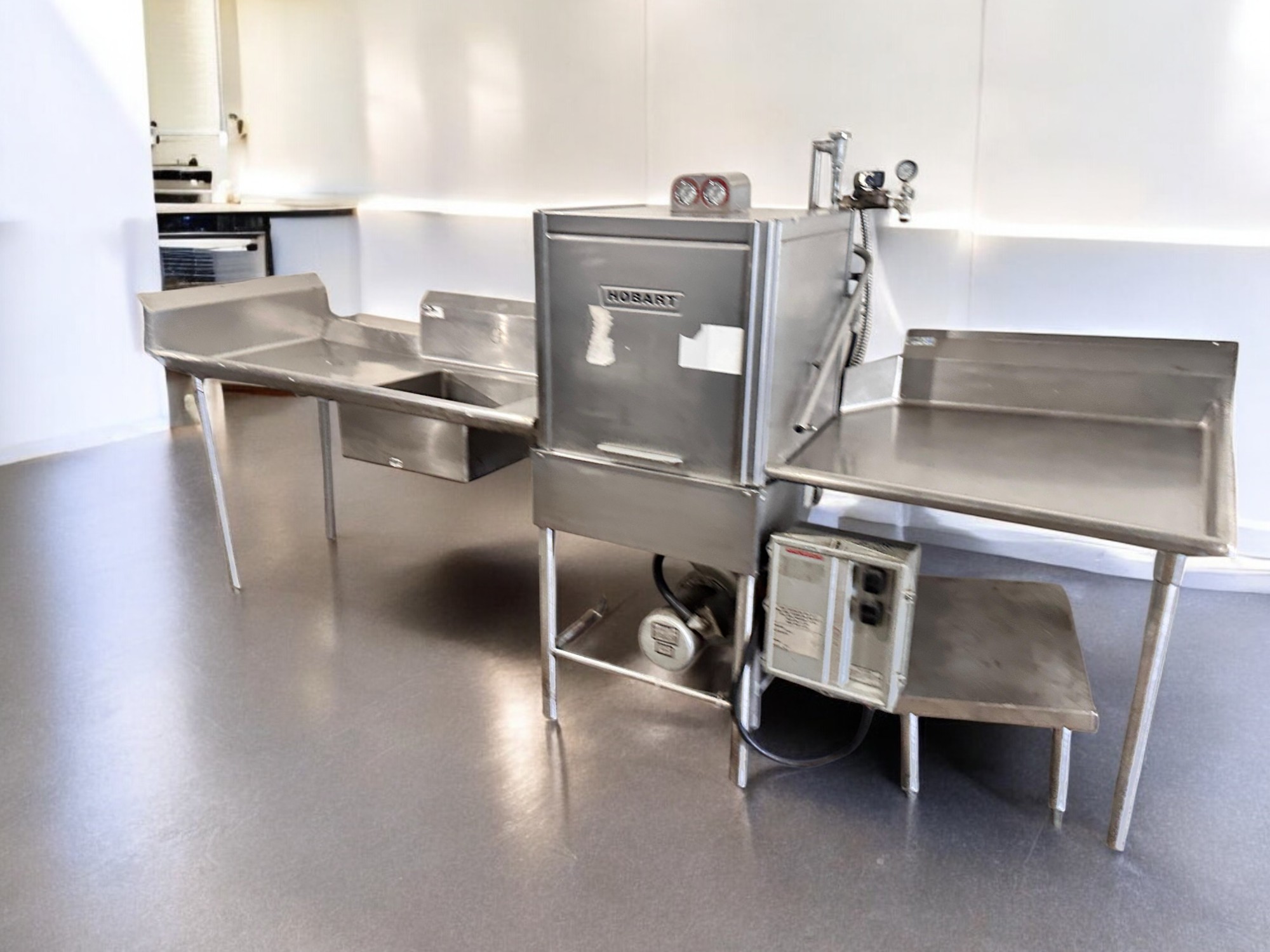
The operation is semi-automated. A dishwasher (the person, not the machine) scrapes plates on the dirty side, pre-rinses with a spray head attached to a rinse sink, loads dishes into standardized racks, and pushes the rack into the dishwasher. The door closes, the cycle runs (approximately 2 minutes), the door opens, and clean dishes emerge on the opposite side. On the clean side, another worker removes the rack, allows dishes to air dry completely, then restocks clean inventory.
Pass-through dishwashers dominated auction sales with 68 units sold over the past year, representing 20% of total volume. The median auction price was $383—lower than undercounter units despite higher capacity, reflecting the fact that pass-through units require dedicated dish pit space and professional installation.
Conveyor Dishwashers: High-Volume Automation
Conveyor systems represent full automation for institutional-scale operations. These machines eliminate manual door operation entirely. Dishwashers scrape plates and load items directly onto a moving conveyor belt. Some systems use standard racks on the belt; others feature integrated conveyor racks that allow massive volumes to be loaded continuously.
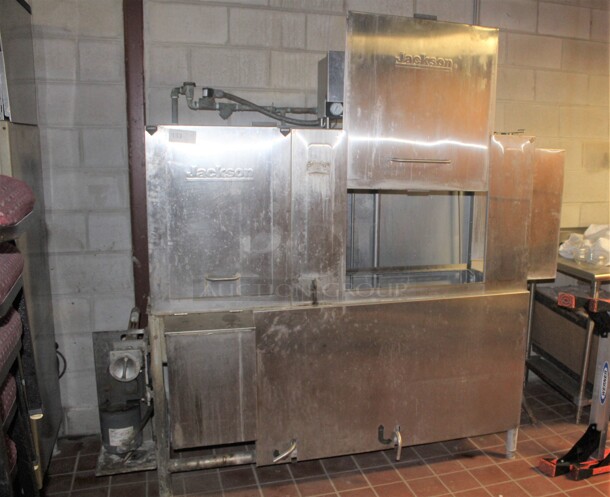
The conveyor automatically moves items through pre-rinse, wash, and sanitize cycles inside the machine. The limiting factor becomes the clean side—if workers cannot unload clean items fast enough, the system backs up and automatically shuts down. For rack-based conveyor systems, this shutdown mechanism is called a "table limit switch." Belt-style conveyors use electric eyes or stop sensors to detect backup conditions. All conveyor units include emergency stop buttons for immediate shutdown.
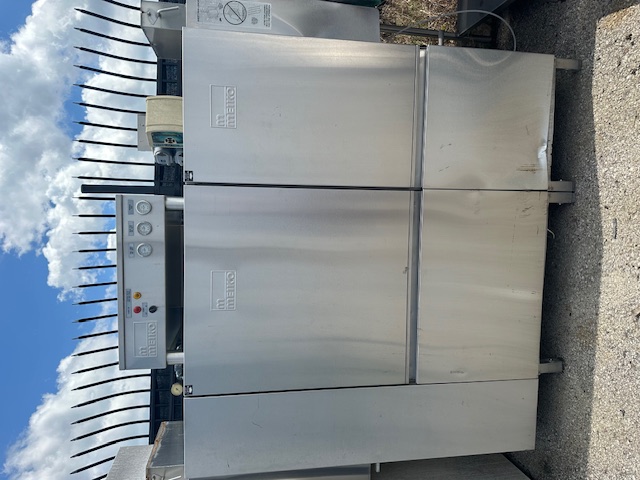
Conveyor systems serve university dining halls, hospital cafeterias, large buffet operations, school cafeterias, and any facility where volume exceeds standard dishwasher capacity. These units rarely appear at auction—only 6 conveyor sales over the past year (less than 2% of volume). When available, they command premium pricing with a median of $675.
Market Reality: 340 Sales Analyzed
Analysis of 340 commercial dishwasher sales over the past year reveals dramatic price spreads and clear brand hierarchies. The data includes all dishwasher types, brands, and conditions sold through auction.
- Median sale price: $210
- Mean sale price: $620 (elevated by high-end units)
- Price range: $0 to $5,249
- 25th percentile: $51
- 75th percentile: $775
The $210 median represents typical auction outcomes—used equipment with unknown functionality but acceptable cosmetic condition. The gap between median ($210) and mean ($620) reflects the influence of brand-new scratch-and-dent units selling in the $3,000-$5,249 range at the top of the market.
Price Distribution by Tier
| Price Range | % of Sales | Typical Condition |
|---|---|---|
| Under $100 | 25% | Parts units, severe damage, incomplete machines |
| $100-$300 | 35% | Used equipment, unknown condition, typical auction units |
| $300-$500 | 15% | Better cosmetic condition, complete units, likely functional |
| $500-$1,000 | 12% | Good condition used units, recent model years |
| $1,000-$3,000 | 8% | Near-certain functionality, minimal repairs |
| Over $3,000 | 5% | Brand new scratch-and-dent units, premium models |
Brand Hierarchy: The Numbers Tell the Story
Brand performance varies significantly. The following analysis excludes parts and accessories (85 units with $22 median) to focus on complete dishwashing machines.
| Brand | Units Sold | Median Price | Range |
|---|---|---|---|
| Hobart (ITW) | 75 | $951 | $36 - $5,249 |
| Noble Warewashing | 36 | $988 | $0.52 - $3,600 |
| CMA (Ali Group) | 20 | $475 | $85 - $1,605 |
| Jackson (Hoshizaki) | 19 | $390 | $21 - $3,100 |
| Champion (Ali Group) | 14 | $423 | $7 - $3,000 |
| American Dish Service | 11 | $432 | $24 - $775 |
Hobart: The Industry Standard
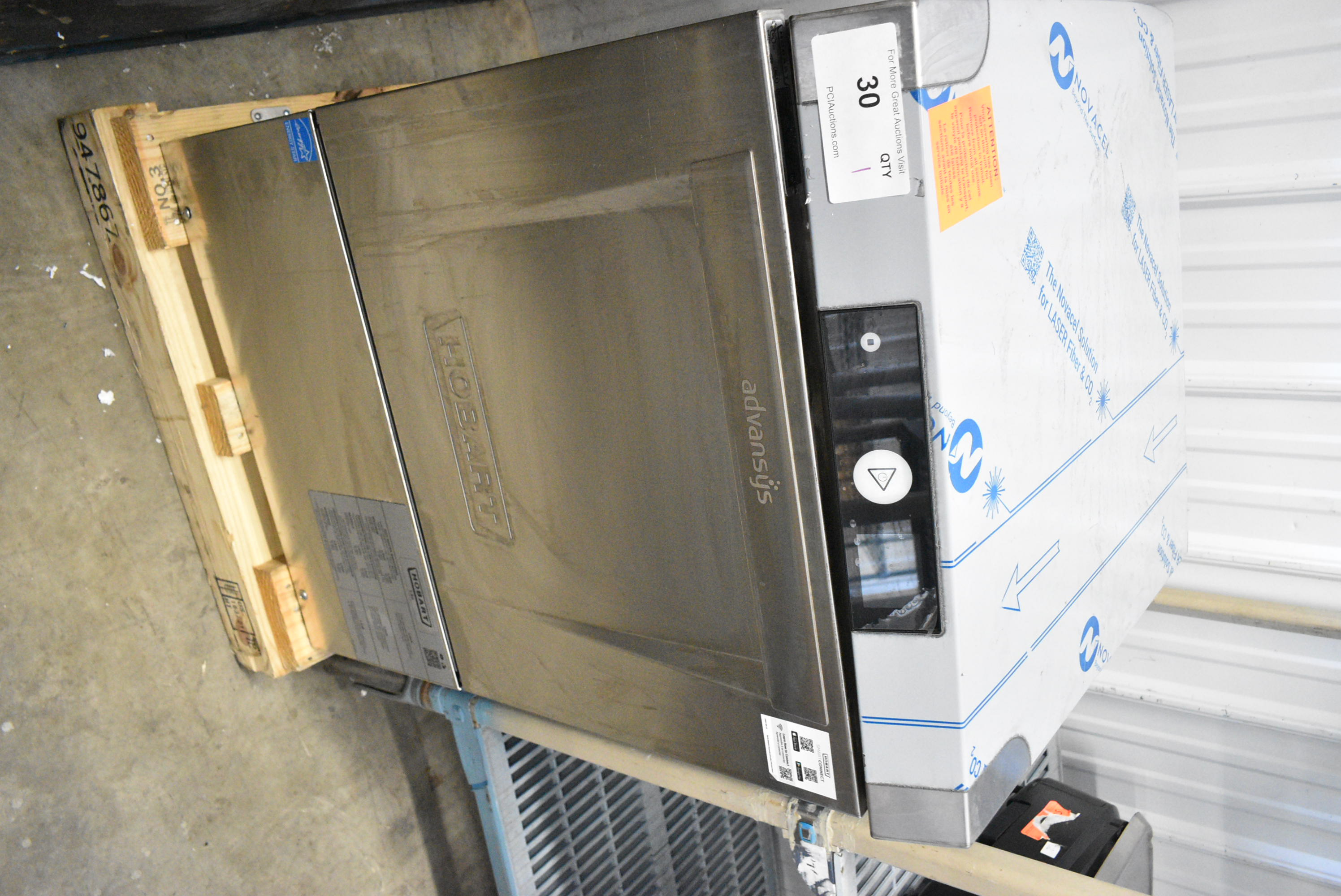
Hobart dominates commercial dishwasher sales through reputation, performance, and service network accessibility. As part of ITW (Illinois Tool Works), Hobart maintains robust parts availability and technician familiarity across North America. The brand produces quality equipment with documented reliability in high-volume environments.
Key Hobart model lines include the Advansys LXN series (LXNR, LXNH, LXEC) for undercounter applications and the EcoLine series (EDH-1) for pass-through installations. The AM15VL and AM15VLT models represent premium pass-through units with advanced features and higher capacity. These specific models appear frequently in auction sales and command premium pricing even when used.
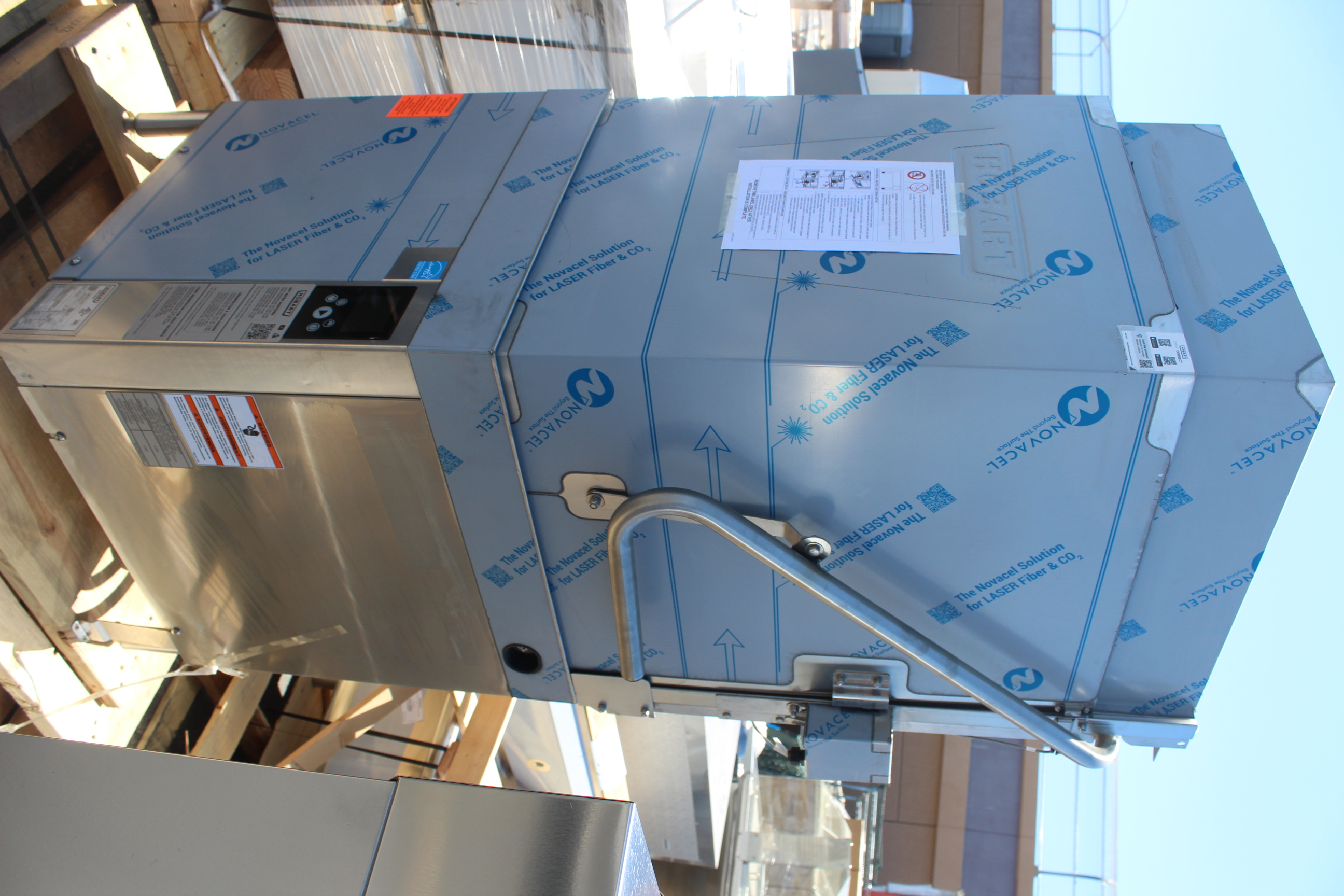
Noble Warewashing: The Specialist Alternative
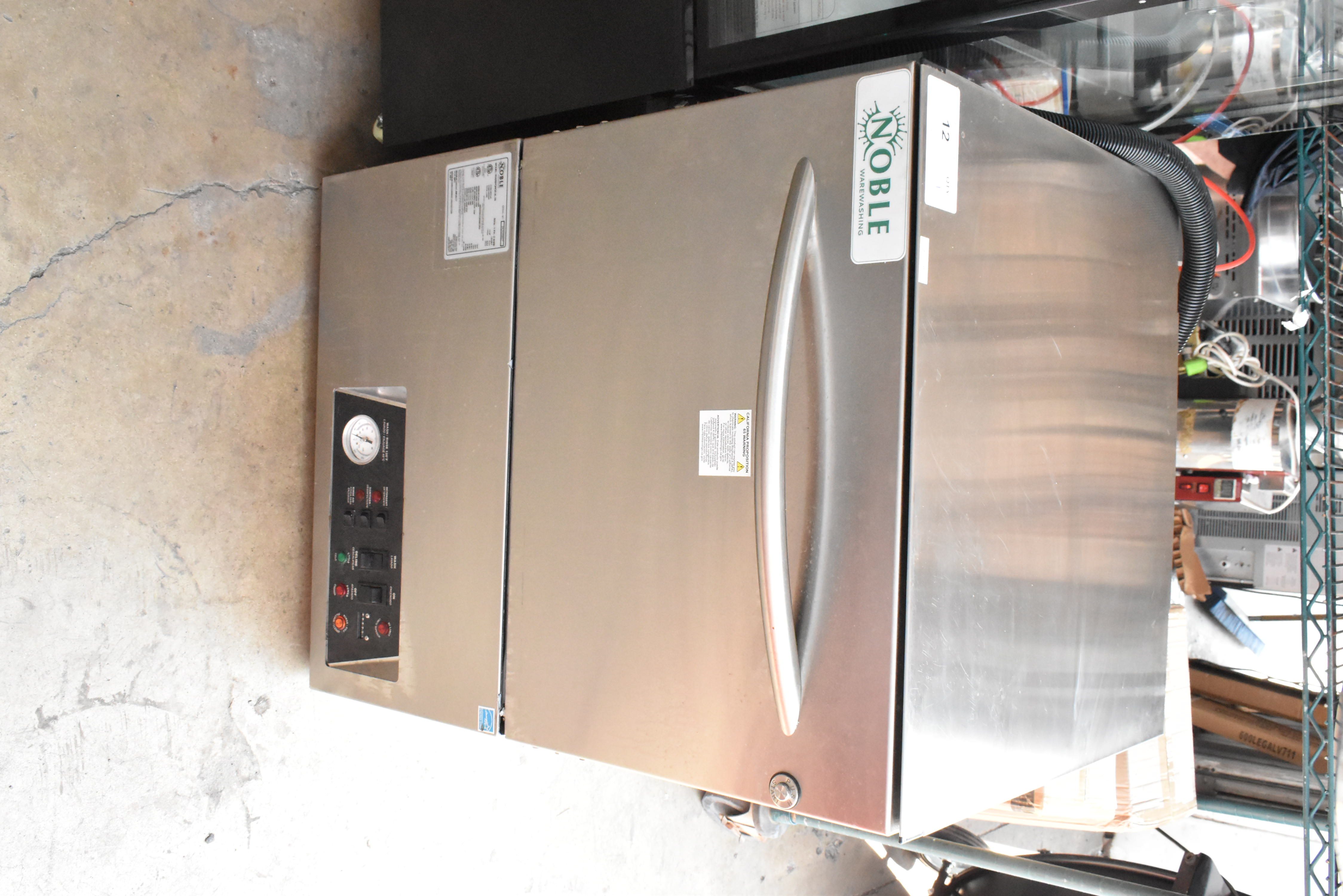
Noble Warewashing focuses exclusively on dishwashing equipment. This specialization produces competitive performance with strong parts and service networks. The brand partners with major foodservice equipment distributors, resulting in consistent availability of brand-new scratch-and-dent units at auction—cosmetically imperfect machines sold at significant discounts from retail despite full functionality.
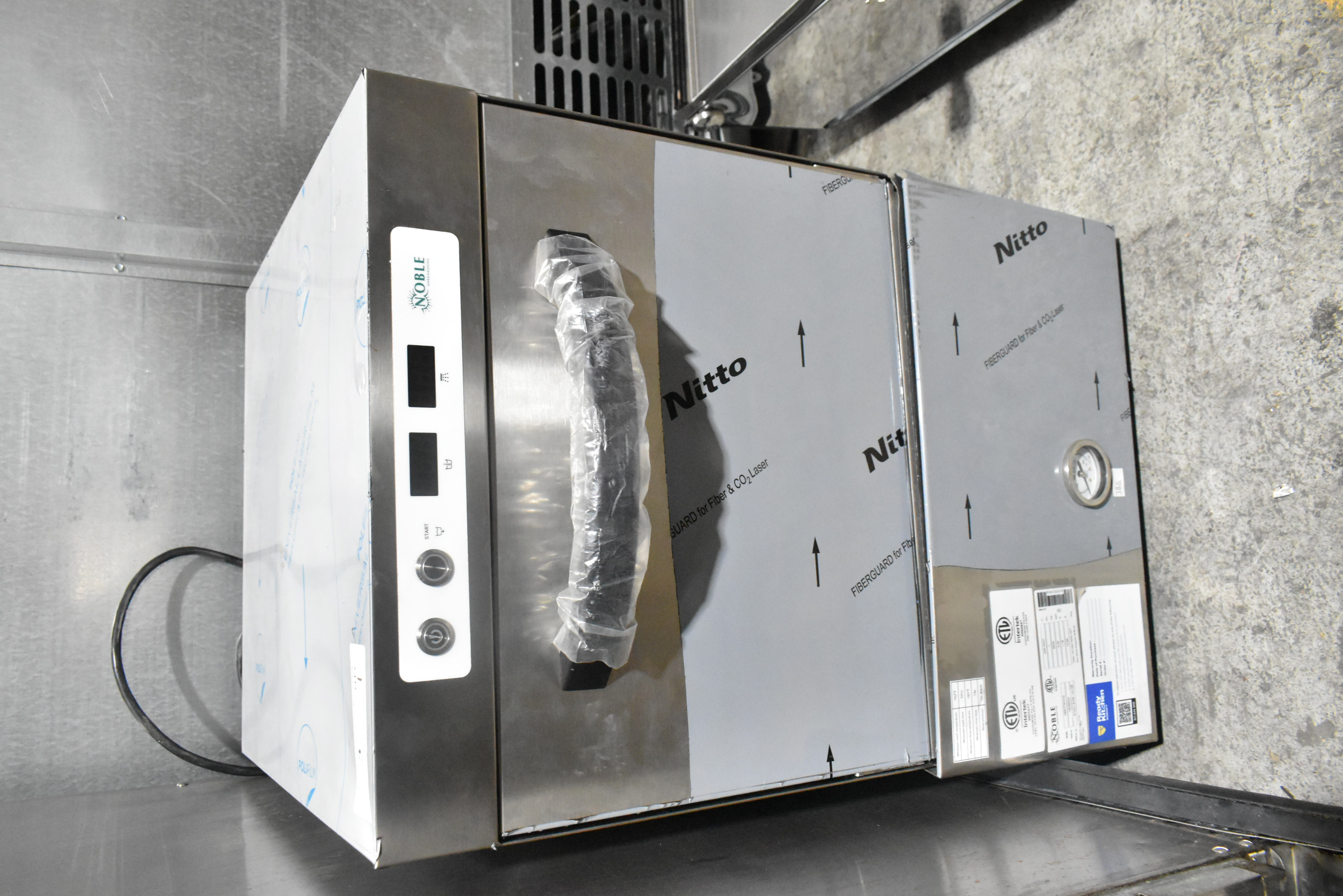
Noble's median auction price ($988) nearly matches Hobart ($951), indicating market recognition of quality and serviceability. The brand delivers legitimate performance without requiring premium retail pricing.
CMA Dishmachines: Solid Mid-Tier
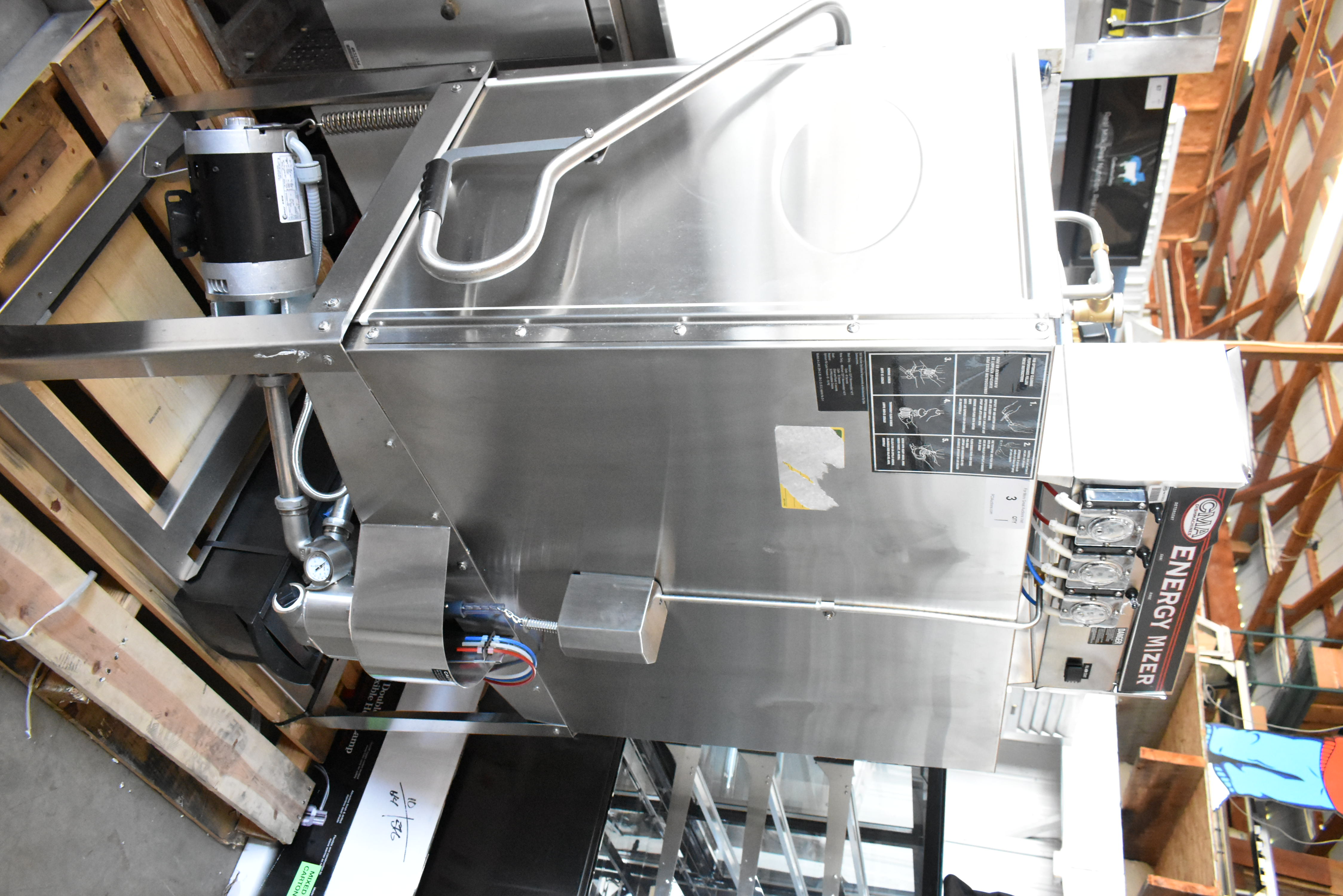
CMA operates as part of Ali Group, one of the world's largest foodservice equipment conglomerates. This corporate backing ensures parts availability and service network coverage. CMA produces well-built machines at mid-market price points, making them attractive for budget-conscious operations requiring reliable performance.
Jackson: Hoshizaki Engineering
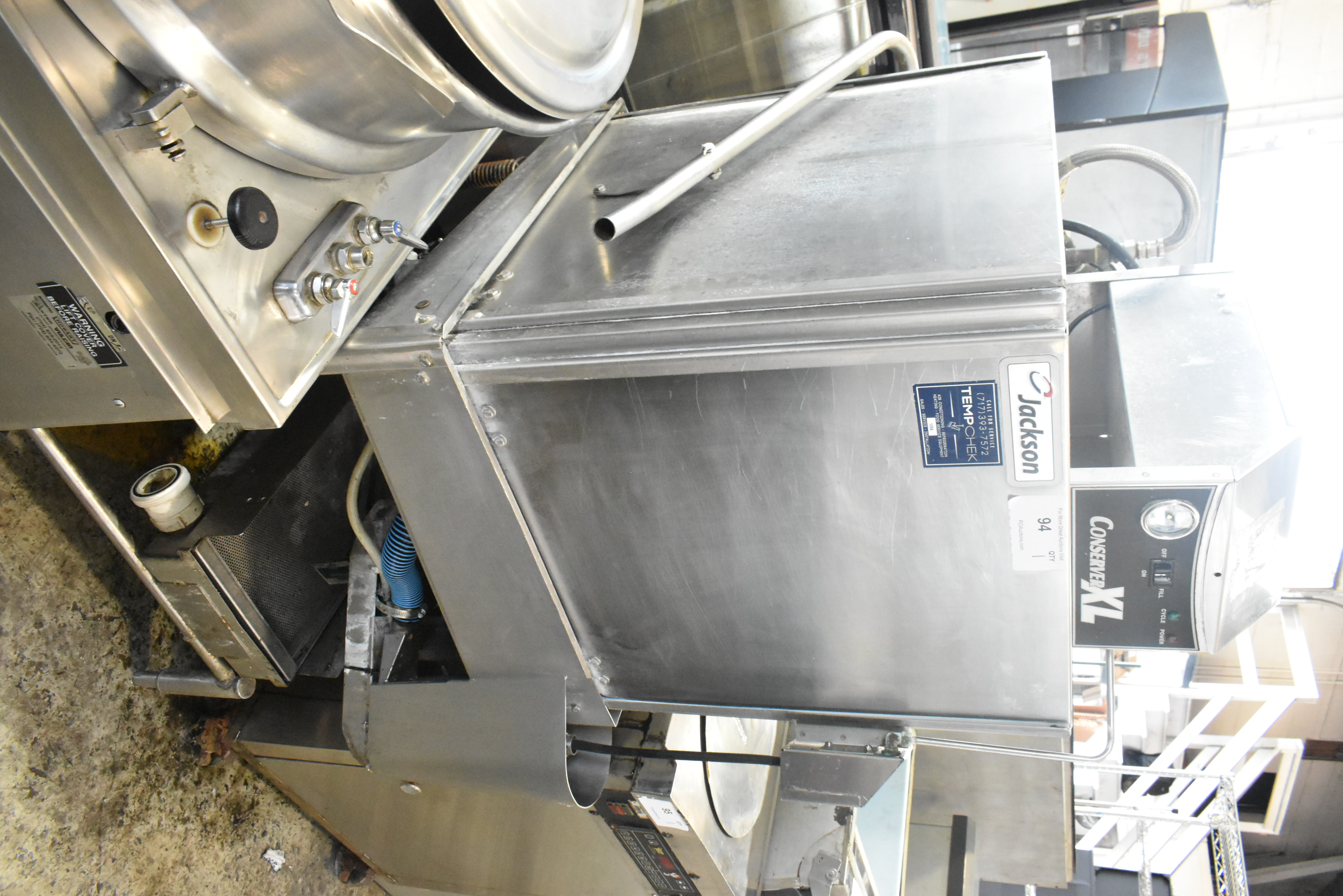
Jackson operates under Hoshizaki ownership, leveraging the parent company's engineering expertise and distribution network. The brand produces competitive equipment with particular strength in undercounter models. Lower auction median pricing reflects market positioning rather than quality concerns.
Champion: Ali Group Volume Producer
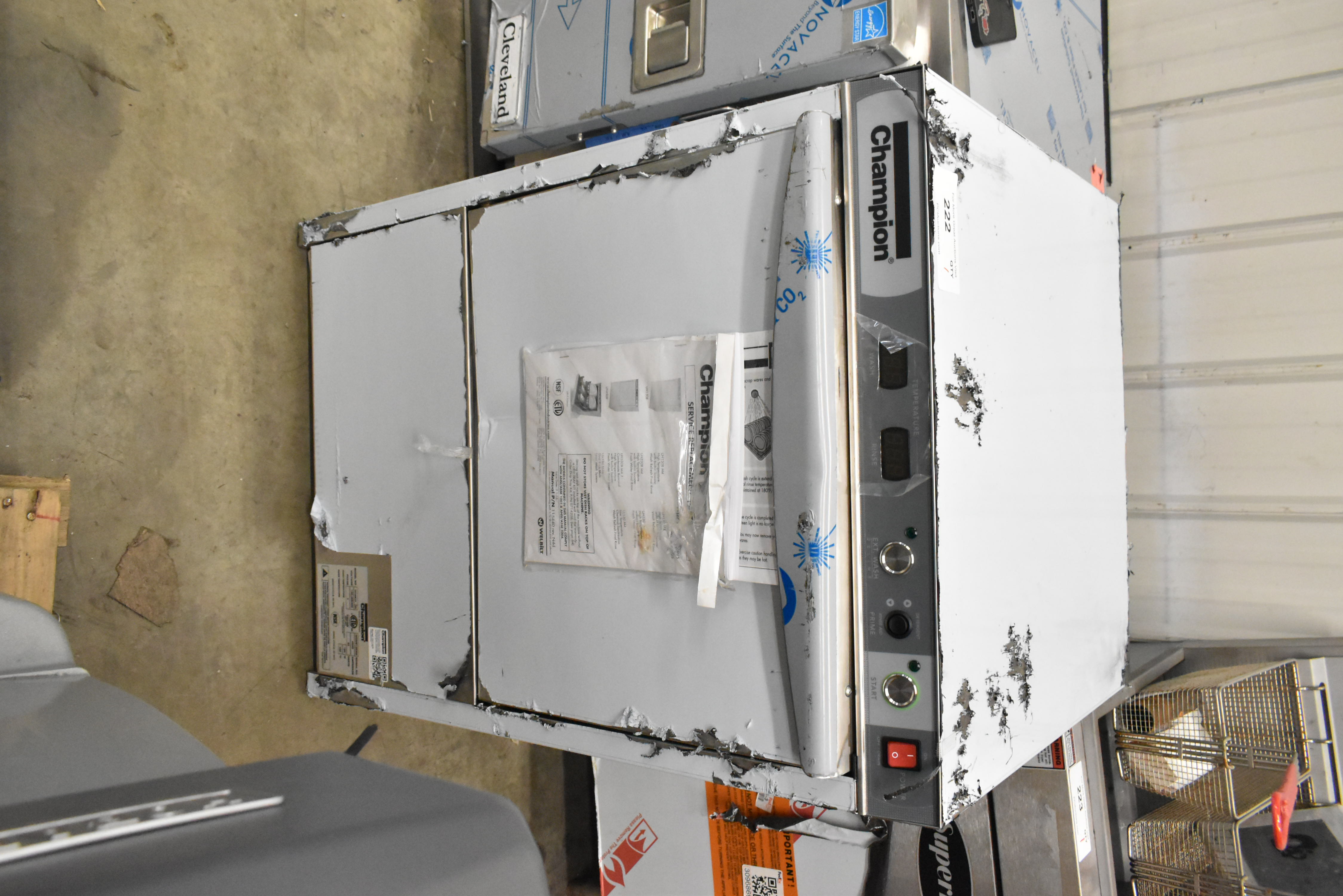
Champion, also part of Ali Group alongside CMA, produces high-volume equipment for commercial applications. The brand emphasizes straightforward operation and serviceability. Auction pricing reflects mid-market positioning similar to CMA.
Brand Selection Reality
For major brands (Hobart, Noble, CMA, Jackson, Champion, ADS), parts availability and service networks are adequate. Brand choice becomes personal preference influenced by specific features, capacity requirements, and high-temperature versus chemical sanitization decisions. All maintain technical documentation and serviceable designs.
Avoid unknown or imported brands. If you haven't heard of the manufacturer, parts sourcing becomes problematic. Proprietary components with limited North American distribution create maintenance nightmares.
Critical Inspection Points
Commercial dishwashers sold at auction arrive untested. Most units are hardwired rather than plug-in devices, making powered testing during preview impractical for safety reasons. Visual inspection becomes the primary evaluation tool.
Hard Water Deposits: The Silent Killer
Hard water causes more dishwasher failures than any other factor. Mineral deposits accumulate in spray arms, jets, pumps, and water lines. These deposits restrict water flow, reduce spray pressure, prevent proper sanitization temperatures, and eventually cause component failure.
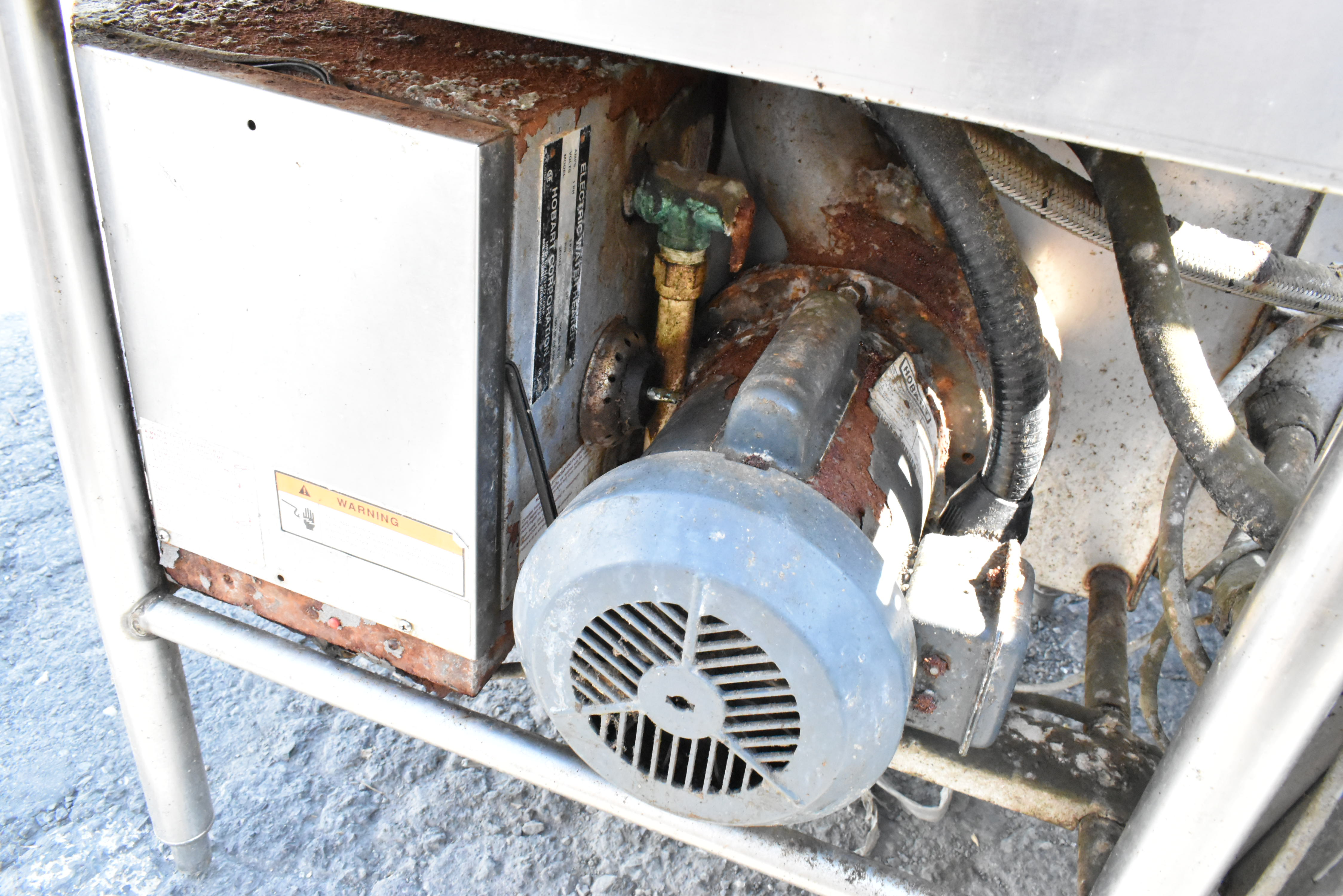
During preview inspection, examine spray arms and visible jets closely. White, chalky buildup indicates hard water exposure. Check interior surfaces for mineral scaling. Look for rust or corrosion—these often accompany hard water conditions as minerals accelerate metal deterioration.
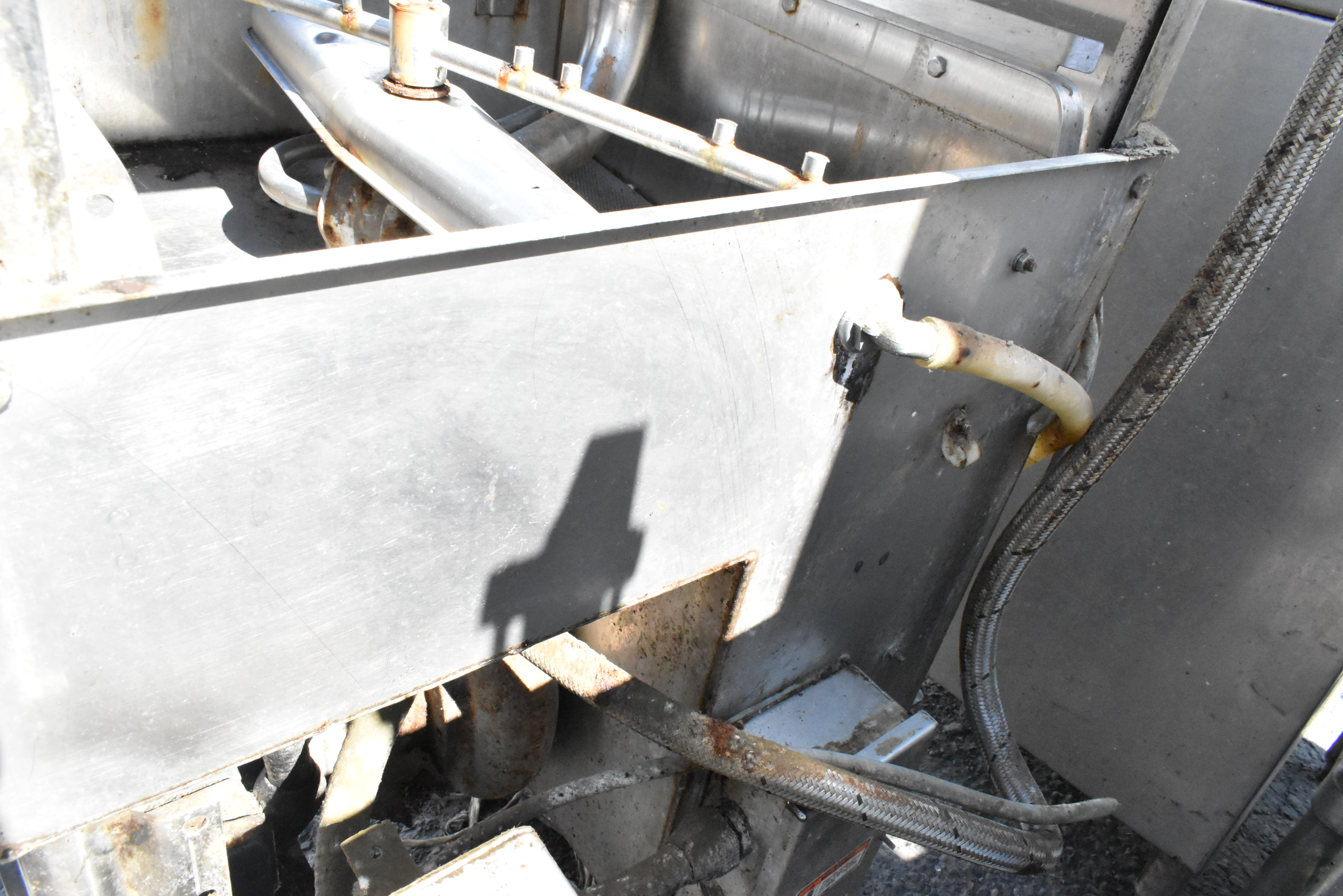
Prevention beats remediation. Hard water solutions include water filtration systems, regular descaling maintenance, and chemical treatment of supply water. This isn't a "wait until it breaks" scenario—by that point, remediation becomes expensive and time-consuming. Proactive approach wins, like kitchen prep work.
Interior Cleanliness Tells a Story
A clean interior cavity suggests proper operational care. If the previous operator maintained cleanliness standards, they likely followed maintenance protocols for pumps, spray arms, and heating elements. Clean equipment correlates with functionality.
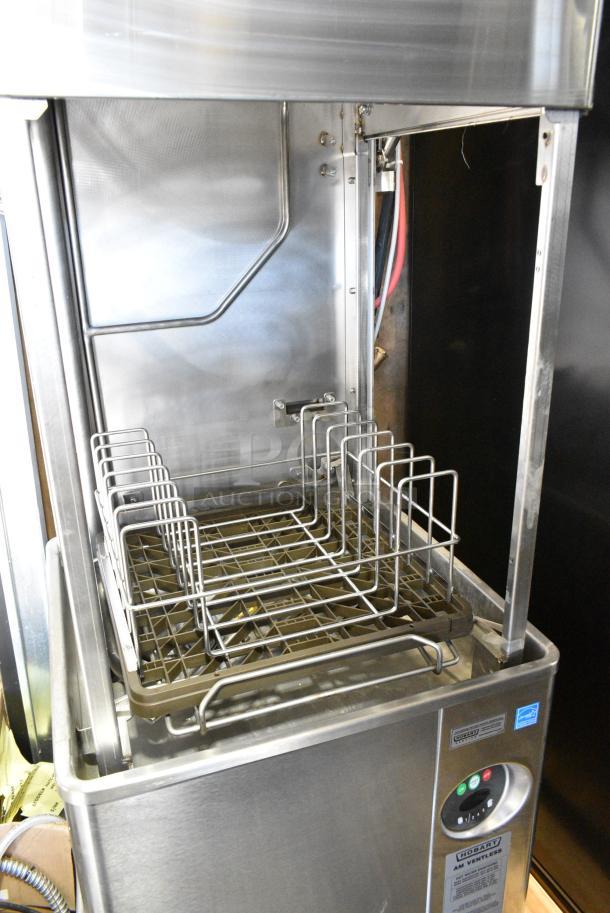
Conversely, heavily soiled interiors with food debris, grease buildup, or standing water indicate operational neglect. This doesn't guarantee mechanical failure, but it reduces confidence in hidden component condition. Clean units deserve higher bids because maintenance history matters more than age.
Spray Arms and Jets: The Distribution System
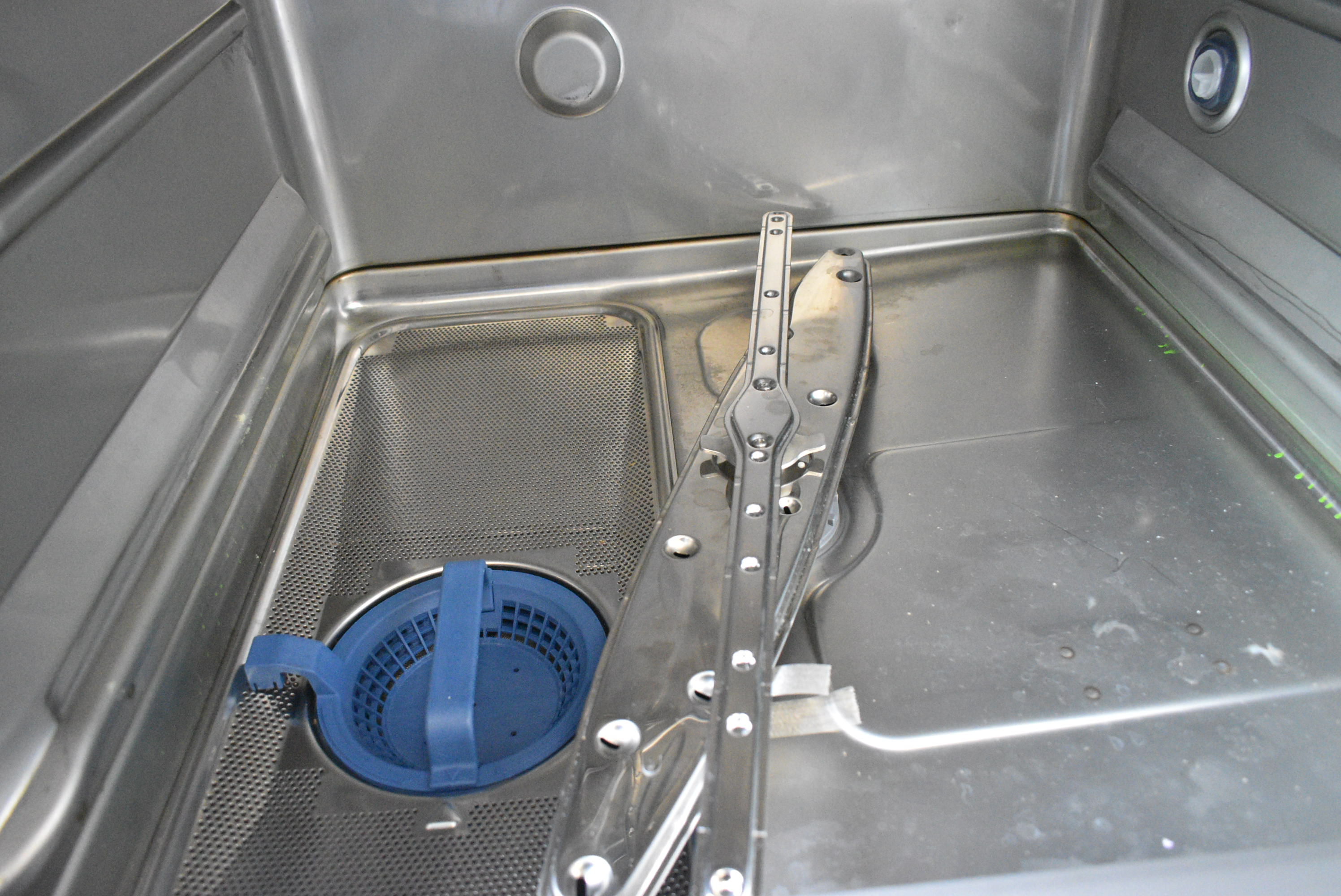
Commercial dishwashers use multiple spray arms to distribute water and detergent throughout the cavity. These arms rotate during cycles, ensuring complete coverage. Inspect arms for visible damage, bent sections, or clogged jets.
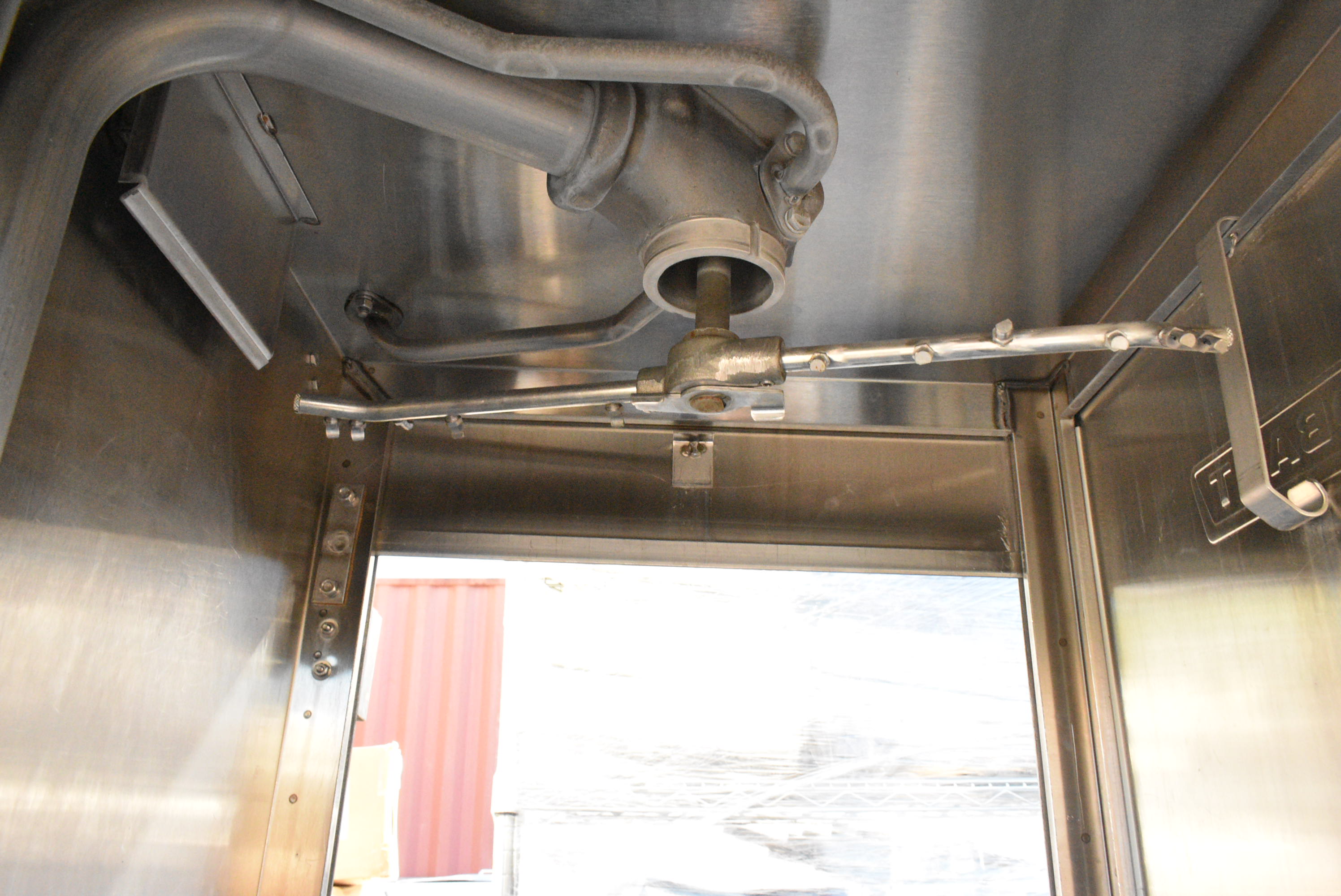
Upper and lower spray systems work together. The upper arm washes tops of plates and bowls; the lower arm handles undersides and interior surfaces of cups and glasses. Both systems must function properly for effective cleaning.
Control Panel Condition
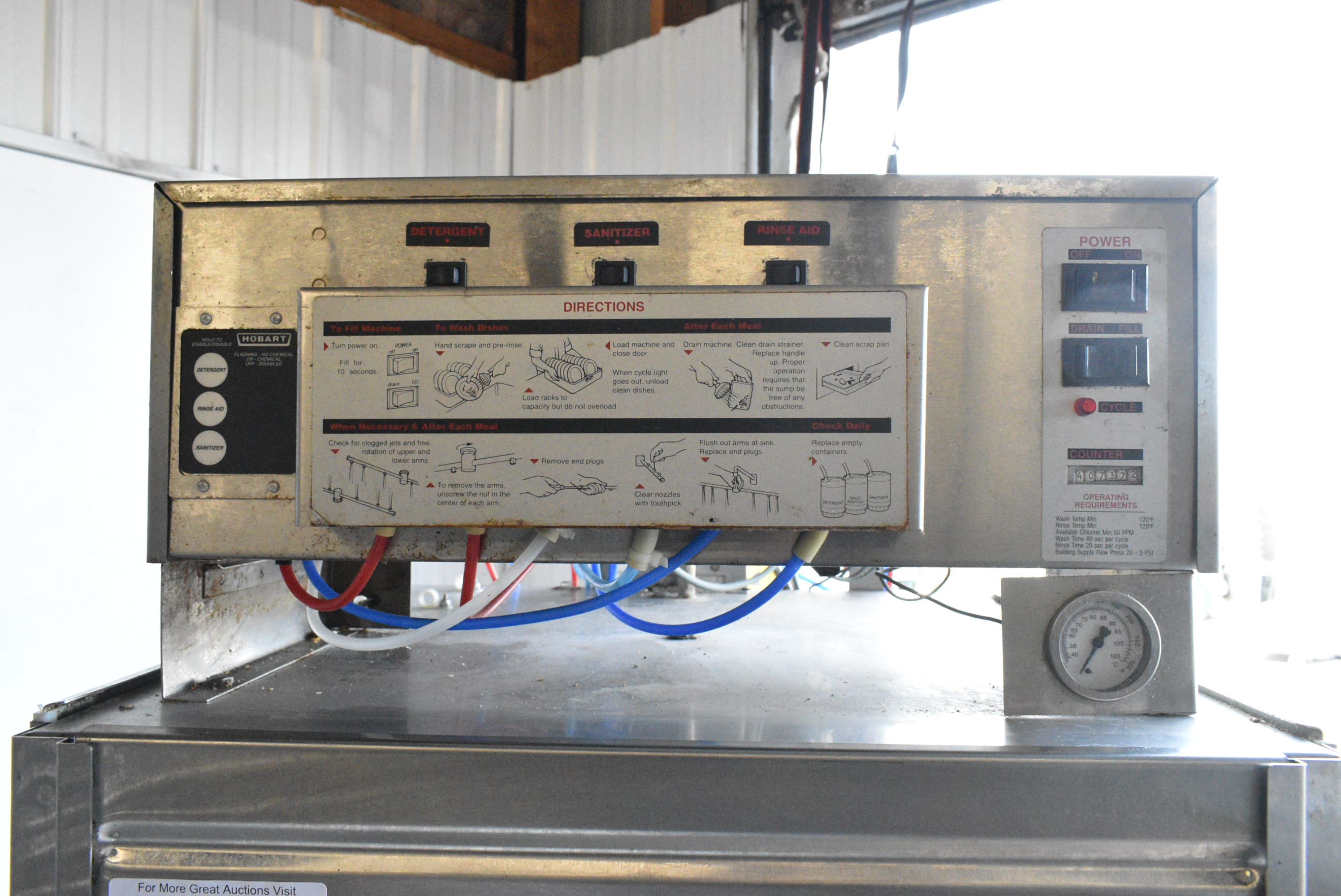
Control panels range from simple mechanical switches to digital touchscreens depending on model age and sophistication. Both styles work effectively when functional, but damage has different implications.
Mechanical control panels use physical switches, knobs, and timers. These systems are durable and straightforward. Look for cracked or missing knobs, non-responsive buttons, or visible water damage around controls. Mechanical failures are usually repairable.

Digital panels with touchscreens provide more programming capability but cost significantly more to repair or replace. Check for cracked screens, non-responsive areas, or visible liquid damage behind the display. Control board replacements run $500-$1,500 depending on model. Factor this into bidding if panel damage is evident.
Specification Plates: The Technical Truth

Every commercial dishwasher has a specification plate listing electrical requirements, water specifications, and model information. This plate provides critical data for installation planning. Verify voltage and phase requirements match your facility capabilities before bidding.
Water and Chemical Connections

The rear of undercounter units typically shows water inlet connections, drain connections, and chemical dispenser lines for detergent, rinse aid, and sanitizer. Check connection points for corrosion, damage, or previous repair attempts.
High-Temperature vs Chemical Sanitization
Commercial dishwashers use two sanitization methods: high-temperature water or chemical additives. This choice significantly impacts installation requirements, operating costs, and equipment complexity.
High-Temperature Sanitization
High-temperature units heat final rinse water to 180°F minimum—the temperature required to kill bacteria and pathogens through heat alone. These machines are generally faster, handle heavier soil loads more effectively, and require fewer chemical additives beyond standard detergent.
High-temperature models often include or require booster heaters—supplemental water heating systems that bring incoming water up to sanitization temperature even when building hot water supply is inadequate.

Booster heaters can be standalone units or integrated into the dishwasher. They function as heat exchangers that preheat incoming cold water using waste heat from the wash cycle, improving energy efficiency over time.

Chemical Sanitization
Chemical sanitization uses lower water temperatures combined with sanitizing chemicals to achieve pathogen elimination. These units don't require steam hoods because they generate minimal steam. This eliminates the $10,000-$25,000 hood installation expense, making chemical sanitization attractive for locations with budget constraints or inadequate ventilation infrastructure.
The tradeoff: chemical sanitized machines typically run longer cycles, may struggle with heavily soiled items, and require ongoing chemical costs. Operators must maintain proper sanitizer concentration and ensure adequate supply.
Companies like Ecolab specialize in commercial dishwashing chemicals and automatic dispensing systems. These services provide bulk detergent, sanitizer, and rinse aid with automatic replenishment. This convenience carries significant ongoing costs. Shop multiple suppliers and compare service agreements—chemical costs represent substantial operating expenses over the machine's lifetime.
Technical Requirements and Installation Reality
Commercial dishwashers require significant infrastructure. Unlike countertop equipment that needs only electrical power, dishwashers demand water supply, drainage, electrical service, chemical dispensing, and potentially ventilation. Professional installation is strongly recommended—this is not DIY-friendly equipment.
Water Supply Requirements
- General use: 2-7 GPM (gallons per minute) for full operation
- High-temperature units: 0.5 GPR (gallons per rack) - more efficient
- Chemical sanitized units: Up to 2 GPR - higher water consumption
- Supply line diameter: 3/4-inch standard (1-inch for conveyor models)
- Minimum pressure: 20 PSI at connection point
Code requirements mandate a dedicated shutoff valve for the dishwasher water supply. Drainage requires either a backflow preventer or an air gap to prevent contaminated water from flowing back into potable water supply—critical for health department approval.
Grease Trap Requirements
Grease traps are mandatory in most jurisdictions for environmental protection and plumbing system maintenance. Unfiltered grease in wastewater causes significant environmental damage and creates catastrophic clogs in building plumbing systems. For most installations, the grease trap connects to the rinse sink and dishwasher drainage, positioned nearby for regular maintenance access.
Electrical Service
Commercial dishwashers require substantial electrical power. Most units need 208-240V service. Undercounter models sometimes operate on 120V, but pass-through and conveyor units demand higher voltage. Large conveyor systems may require 480V three-phase power.
Most commercial dishwashers use hardwired connections rather than plug-in cords. This permanent wiring requires licensed electrician installation and makes powered testing during auction preview impractical.
Professional Installation Strongly Recommended
Budget $1,000-$3,000 for professional installation of undercounter or pass-through units, excluding any required electrical or plumbing upgrades to building infrastructure. Conveyor systems require substantially higher installation costs due to size and complexity. Hood installation (for high-temperature units) adds $10,000-$25,000.
Rack Systems and Standardization
Commercial dishwashers that use rack-loading systems employ standardized rack dimensions. This standardization allows operators to accumulate racks over time and ensures replacement racks are universally compatible.
- Full-size racks: 19.75" × 19.75"
- Half-size racks: 10" × 19.75"
These dimensions are industry standard across manufacturers. Most commercial dishwashers accepting racks adhere to these specifications.
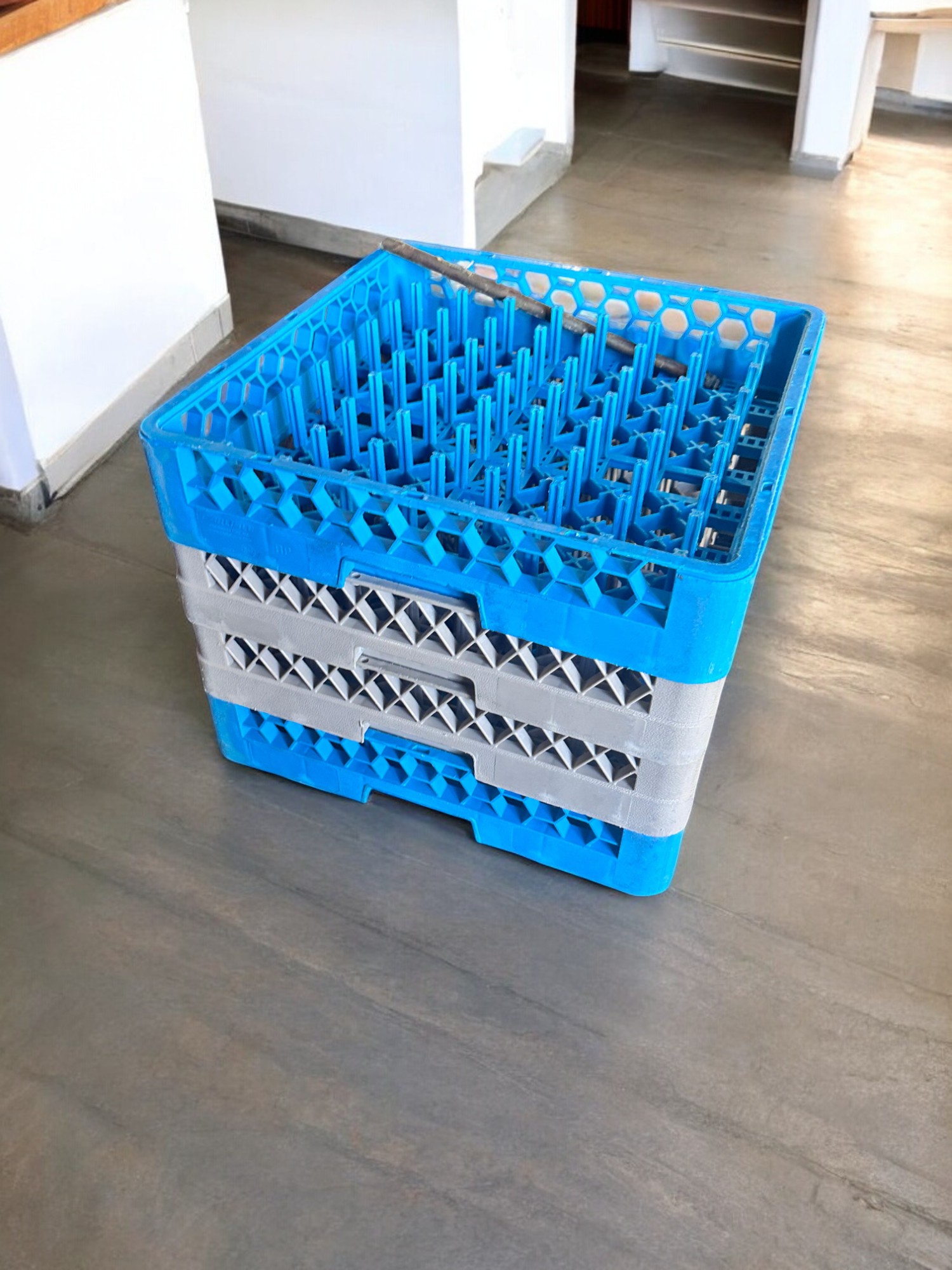
Peg racks feature vertical posts that create compartments for plates, bowls, and pans. The pegs prevent items from nesting together, allowing water and detergent to reach all surfaces.
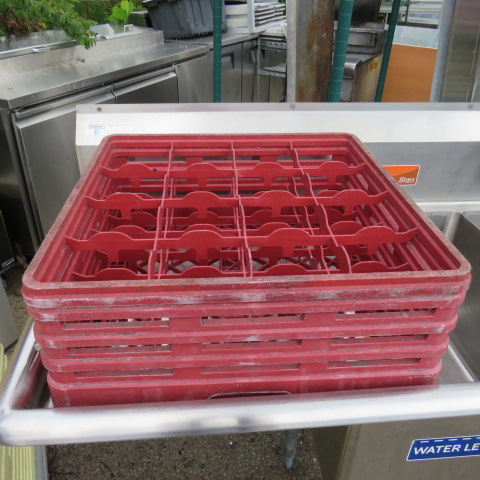
Compartment racks designed for glassware use divided sections that support glasses upside-down, allowing water to flow through interior surfaces while protecting delicate stems and rims.
Rack Strategy
When bidding on auction lots containing racks, consider acquiring extras even if they exceed immediate needs. The phrase "better to have them and not need them than need them and not have them" applies perfectly to dishwasher racks. Replacement racks retail for $30-$80 each. Auction pricing typically runs $5-$15 per rack when sold in lots. Accumulating rack inventory at auction prices provides operational flexibility.
The Scratch-and-Dent Opportunity
Analysis of the top 10 highest-priced dishwasher sales over the past year reveals a pattern: brand-new scratch-and-dent (BNSD) units dominate. Eight of the top 10 sales were BNSD machines selling for $3,100-$5,249. These units are cosmetically damaged during shipping or warehousing—a dent here, a scratch there—but remain fully functional with manufacturer warranties intact.
- Highest-priced sale: Hobart AM15VL pass-through at $5,249 (retail $12,000+)
- Second-highest: 2024 Hobart LXNH undercounter at $5,105 (retail $8,000-$10,000)
- 8 of top 10 sales are BNSD units
- 40-60% discounts from retail pricing
- Full functionality guaranteed
- Manufacturer warranties typically transfer
Major foodservice equipment distributors and manufacturers reject cosmetically imperfect units. These units then flow to auction where back-of-house buyers recognize the value proposition: fully functional commercial equipment at deep discounts simply because of invisible cosmetic damage. No customer will ever see the dent on the side panel of a pass-through dishwasher installed in the dish pit.
BNSD units represent the lowest-risk auction purchases. Functionality is guaranteed. The only compromise is cosmetic imperfection invisible to customers. For buyers seeking maximum value with minimum risk, BNSD dishwashers deliver unmatched economics.
Bidding Strategy by Price Tier
The 340-unit auction database reveals clear price tiers corresponding to risk levels and expected condition. Smart bidding requires understanding these tiers and calibrating bids to acceptable risk tolerance.
Under $100: Parts Machines
Units selling below $100 typically have obvious major damage, missing components, or severe functional issues. These are parts machines—buy them to harvest components for other equipment or to gamble on cheap repair projects. Don't expect functional units at this price point.
$100-$300: The Volume Sweet Spot
This tier represents 35% of auction sales and offers the best risk-reward ratio for experienced buyers. Units show acceptable cosmetic condition, appear complete, and likely came from closed restaurants with unknown maintenance histories.
Smart Bidding for $100-$300 Tier
Budget for potential repairs. If you purchase at $200 and spend $500 on professional service, your total investment remains $700—still exceptional value compared to $3,000-$8,000 retail pricing for comparable used equipment. The key is combining low acquisition cost with realistic repair expectations.
Look for units with clean interiors, minimal hard water deposits, intact control panels, and complete external condition. These visual cues increase functionality probability even without powered testing.
$300-$500: Better Condition, Higher Confidence
This tier (15% of sales) represents cleaner units from better-maintained operations. Cosmetic condition improves, model years are more recent, and completeness is nearly guaranteed. Functionality probability increases substantially compared to sub-$300 units. At this price point, expect minor repairs at most.
$500-$1,000: Near-Certain Functionality
Units reaching this tier (12% of sales) typically work with minimal or no repairs required. You're paying premium auction pricing for reduced risk. This tier makes sense for buyers lacking in-house repair capability or time to troubleshoot.
$1,000-$3,000: Low Hours, Recent Models
This tier (8% of sales) consists of nearly-new equipment from failed restaurants, lease returns, or high-end models from premium operations. Condition approaches retail quality. Competition includes equipment dealers and restaurant supply companies. Verify the premium is justified—stay disciplined.
$3,000+: Brand-New Scratch-and-Dent
This tier (5% of sales) represents BNSD units and premium equipment in exceptional condition. These purchases eliminate functionality risk entirely. Competition is fierce because the value proposition is obvious. Set maximum bids based on retail pricing research and stick to limits.
Commercial vs Residential: Why the Difference Matters
Understanding the performance gap between commercial and residential dishwashers explains why restaurants cannot substitute household equipment regardless of budget constraints.
| Specification | Commercial | Residential |
|---|---|---|
| Cycle Time | 2-5 minutes | 60-180 minutes |
| Temperature | 180°F minimum | 120-140°F maximum |
| Construction | Heavy-duty pumps, industrial motors | Light-duty components |
| Weight | 200-400+ pounds | 60-100 pounds |
| Service Life | 5-15 years continuous operation | 8-12 years intermittent use |
This speed difference isn't convenience—it's operational necessity. During dinner service, a busy restaurant processes 300-500 plates, hundreds of glasses, and countless pieces of silverware. Residential cycle times would create immediate operational failure.
Post-Purchase: First Steps
Transportation
The support legs on commercial dishwashers are not designed for lateral forces. Once positioned, avoid dragging or scooting the unit. Leg failure from lateral pressure is common and requires replacement before installation.
First Power-Up
After professional installation, first power-up should occur with someone present capable of immediate shutdown if problems arise. Many units initialize with diagnostic sequences: beeps, display checks, pump tests, and spray arm rotation. This is normal startup behavior.
Run an empty cycle to verify all systems function properly. Check for water leaks at all connection points. Listen for unusual noises from pumps or motors—grinding, squealing, or excessive vibration suggest component problems requiring attention.
Hard Water Assessment
Test your water supply for hardness levels. If hardness exceeds 7 grains per gallon, implement water treatment solutions immediately:
- Water softening systems installed on dishwasher supply lines
- Chemical descaling treatments run regularly
- Preventive maintenance schedule including spray arm cleaning and deliming
Prevention Beats Remediation
Don't wait for visible mineral buildup to address hard water. Proactive treatment prevents expensive component replacement later. This is preventive maintenance, not reactive repair.
Long-Term Ownership and Maintenance
Daily Maintenance
- Clean food debris from spray arms and strainer screens
- Wipe down door gaskets and check for proper sealing
- Inspect interior cavity for standing water or drainage issues
- Verify chemical dispensers have adequate supply
- Check exterior for water leaks at connection points
Weekly Maintenance
- Delime spray arms and jets if hard water is present
- Clean interior walls and door surfaces
- Inspect drain connections for clogs or buildup
- Test wash and rinse temperatures to verify proper operation
Monthly Maintenance
- Descale entire machine if operating in hard water area
- Inspect door latch mechanism for wear
- Check pump operation and listen for unusual sounds
- Verify all electrical connections remain tight and dry
- Service or clean grease trap according to local requirements
Parts Availability and Costs
| Component | Typical Cost | Lead Time |
|---|---|---|
| Door gaskets | $30-$80 | Same day - 3 days |
| Spray arms | $50-$150 | 3-7 days |
| Pumps | $200-$500 | 3-7 days |
| Heating elements | $100-$300 | 3-7 days |
| Control boards | $500-$1,500 | 5-10 days |
For major brands—Hobart (ITW), Noble Warewashing, CMA (Ali Group), Jackson (Hoshizaki), Champion (Ali Group), and American Dish Service—parts availability is adequate through authorized distributors and commercial parts suppliers.
Final Assessment
Commercial dishwashers represent essential infrastructure for restaurant operations. Unlike glamorous kitchen line equipment or customer-facing espresso machines, dishwashers operate in back-of-house utility spaces performing unglamorous but critical functions. Operational failure stops service immediately.
- Median auction price: $210 vs retail $3,000-$12,000
- Best risk-reward tier: $100-$300 (35% of market)
- Premium BNSD tier: $3,000-$5,249 (40-60% off retail)
- Top brands: Hobart ($951 median), Noble ($988 median)
- Service life: 5-15 years with proper maintenance
The auction market rewards strategic thinking. With 340+ units available annually and median prices around $210, supply consistently exceeds demand. Smart buyers focus on matching equipment to needs rather than winning individual auctions.
Critical inspection focuses on hard water damage—the primary killer of commercial dishwashers. Visual assessment of spray arms, interior surfaces, and component condition provides strong indicators of maintenance history and potential functionality. Clean units from well-maintained operations deserve premium bids because care translates to reliability.
Installation requires professional expertise. Budget $1,000-$3,000 for professional installation plus any required building infrastructure upgrades. High-temperature units require steam hood installation ($10,000-$25,000) but operate faster with fewer chemicals. Chemical sanitized units eliminate hood costs but add ongoing chemical expenses.
The dish pit determines restaurant success more than any other operational area. Clean dishes maintain reputation and health department compliance. Dirty or improperly sanitized wares destroy businesses faster than poor food quality. This reality makes the commercial dishwasher a critical investment worthy of careful selection and proper maintenance.
Final Bidding Advice
Focus on recognized brands (Hobart, Noble, CMA, Jackson, Champion) with confirmed parts availability. Prioritize units showing minimal hard water damage and clean interior condition. Verify electrical requirements match facility capabilities before bidding. Budget for professional installation and factor in potential repairs when setting maximum bids.
With these fundamentals guiding purchasing decisions, commercial dishwasher auctions become high-probability investments rather than gambles.
Ready to Bid on Commercial Restaurant Equipment?
PCI Auctions offers 600-900 lots weekly of restaurant and foodservice equipment including commercial dishwashers, refrigeration, cooking equipment, and complete restaurant liquidations.
Preview in person at our Manheim, Pennsylvania facility, inspect equipment before bidding, and leverage auction pricing for your operation.
View Current Auctions